'Blues' is a nickname, or street name for the following basic dance beat family. There are more than 16,000,000 ways to alter, or vary this basic drumset rhythm. You'll need at least a handful of these variations when playing modern music styles.
6/8 Blues:
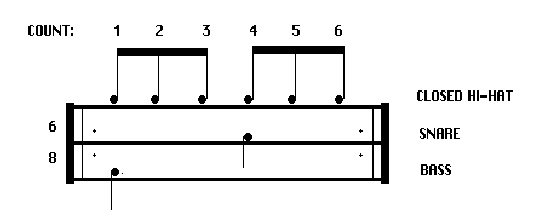
This dancebeat may tend to take on several other technical names, depending on how it is written. It may be written and referred to as 6/8 or 12/8 (Blues). The 12/8 version includes two repetitions of the pattern. This beat may also be written and referred to as a triplet 2/4 or triplet 4/4 (Blues). The 4/4 version includes two repetitions of the pattern.
The 6/8 (or triplet 2/4) versions contain 4,896 possible variations like the examples below.
Variation Examples:
EXAMPLE #1:
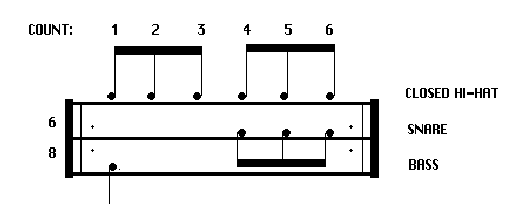
EXAMPLE #2:

EXAMPLE #3:
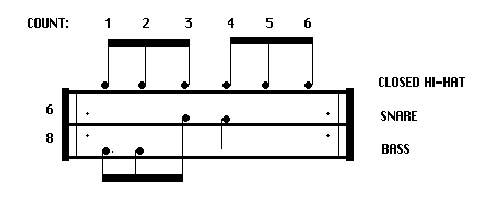
It is common to inject variations like the examples above, into a basic blues beat pattern in progress. In other words, try playing several repetitions of basic blues then play one repetition of a variation and return to the basic pattern.
Later on as you become more proficient with 8th rock syncopations, you will discover that it is easy to adapt many syncopations to the blues beat as well. There are approximately 16 million syncopated possibilities within every measure of a typical 12/8 Blues song. The good news is, only a handfull of those rhythms are commonly used.
EXAMPLE #4: Typical Blues Sync.
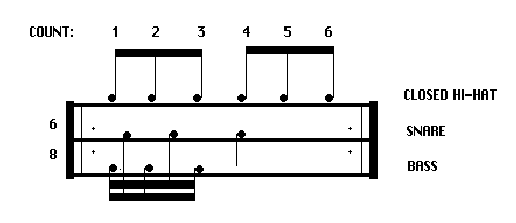
![]() Hear all the blues variations in sequence.
Hear all the blues variations in sequence.
LESSON PROJECT:
Practice these patterns with a 6/8 blues tune that suits your personal taste. Try several different songs that fall into this rhythm framework. Listen to the drummer on the recording and try to imitate the patterns being played. You should get the hang of it quickly.
DROPPING FILLS INTO 6/8 BLUES:
Adding fills to 6/8 blues is tricky. Probably the best way to begin is with 'half measure' fills.
Play the blues beat VERY slowly and count 1, 2, 3, 4, 5, 6 as you repeat the beat pattern over and over. You will want to drop your fill on the numbers 4, 5, & 6, then return to the hi-hat as you begin the next beat repetition on the count of 1.
As an example, we will try a single stroke fill like the one below:
r=right
l=left
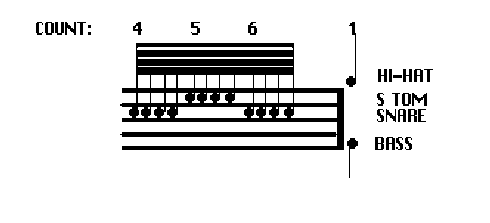
I will try to explain the above fill example.
Begin on the snare, play four notes (rlrl), move up to the tom and play four notes (rlrl) then back to the snare with four (rlrl) more. Follow through to the hi-at (or ride cymb.) after the third repetition of the roll. Connect with the cymbal and bass simultaneously on the count of one.
Practice the above fill until you can play it rapidly, then try other configurations and connect them to a blues beat in progress as shown below:

Note: In the example above the simultaneous cymbal and bass at the end of the fill *IS* the beginning of the next beat repetition, or count of one.
Though we have played a single stroke fill in the above example, the roll could be ANY roll, like triplets (lrl rlr lrl), paradiddles (lrllrlrrlrll), doubles (rrllrrllrrll). Rolls like flams, ruffs, press rolls and others may also be used in exactly the same way. Simply drop your chosen fill on the numbers 4, 5, and 6 and return to the beat on the count of one.
Remember to keep the beat pattern *VERY* slow and steady! The fills will seem extremely fast compared to the slow beat.
Later on you may want to try playing 'whole measure' fills. To do 'whole measure' fills you would play six repetitions of the chosen roll. One for each count in the beat. Begin your fill on 'one' and end on 'one' of the next measure.
It helps to hear it and see it. If your computer system will allow you to play midi files and video, play the files and listen closely. Sometimes this is the easiest way to learn.
![]() VIDEO: Click here to 'Play', see, and hear this entire lesson.
VIDEO: Click here to 'Play', see, and hear this entire lesson.
QUESTION: (Do you know the answer to the following question?)
- What is the difference between 6/8, 12/8, 8th triplet 2/4, and 8th triplet 4/4?
This lesson will attempt to explain it. Click here for the ANSWER . . .
Finite To Infinity
3 very important questions
IS IT POSSIBLE THAT YOUR 'NATURAL GIFT' OF RHYTHM CAN BE DOUBLED WITH ONLY A LITTLE ADDITIONAL (PREVIOUSLY UNAVAILABLE), KNOWLEDGE?
IS THERE A 'KNOWLEDGE GAP' IN YOUR OWN UNDERSTANDING OF 'RHYTHM'?
IS IT POSSIBLE TO GAIN A COMPLETE AND THOROUGH UNDERSTANDING OF 'ALL RHYTHM', WITHIN ONLY A COUPLE HOURS OF EASY, AND FASCINATING, STUDY ?
Answers: YES! YES! YES!
Get All Products Here
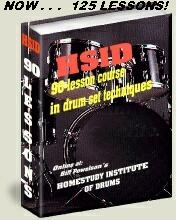
GET ALL THE PRODUCTS AT ONE LOW PRICE.
SURPRISES ABOUND!!!! . . . For those with a bit of generosity in their soul.
CLICK HERE , to see what I mean.
Intermediate & Advanced Drummers
- Drum Instructors Wanted
- Teach My Lessons and Methods
- Up to $60.00/hour
Pre-School Drummer?
Can we teach rhythm to pre-schoolers? YES!
This is a very short course, designed to help adults plant the seeds of rhythm into children of nearly any age. Click Here!!
Make CASH $$$ Now!!!

FREE ELECTRONIC BOOK BONUS (also included) BUSINESS OPPORTUNITY:
- * MAKE BIG MONEY SELLING USED DRUMSETS!
- * INSIDER HARDBALL-BUYING-TIPS AND SECRETS.
- * UNIQUE RECOVERING SECRETS
Support Us Today!!
Support this site and and gain an advetising bargain with the deal. Place a permanent ad here.
